One of the most common sports injuries of the knees is the anterior cruciate ligament sprain or tear. Athletes and high demand sports players are at a greater risk of injuring their anterior cruciate ligaments.
Surgery of the injured anterior cruciate ligament, ACL Tear in Gurgaon, Delhi ensures full functionality of the knee. However, the surgery as a treatment option depends on the activity level and the extent of the injury. Dr. Ratnav Ratan is a renowned sports orthopedic doctor in Gurgaon specializing in effectively treating ACL tears.

On injury of the anterior cruciate ligament, the patient may have heard a ‘pop’ noise within the knee area and feel the knee losing grip or just giving away. The accompanying symptoms are –
Action/cause leading to injury of the anterior cruciate ligament when in a mobile state, the patient –
The incidence of anterior cruciate ligament, ACL Tear in Gurgaon, Delhi occurring in sportswomen is higher than that in sportspeople. Some of the reasons being differences in –
The knee joint is the meeting point of the thighbone, shinbone, and patella. The kneecap covers and protects the knee joint.
Ligaments in the knee are rope-like structures that hold the bones together and give stability to the knee. In all, every human knee has four primary ligaments. Two collateral ligaments are present on the sides of the knee. i.e., inside as well as outside the knee.
Two cruciate ligaments are within the knee joint, and they cross each other to make an ‘X.’ The anterior cruciate ligament is in the front, while the posterior cruciate ligament lies in the back.

Their function is to control the knee’s back and forth movements and provide rotational stability to it.
In most cases, anterior cruciate ligament tear occurs along with injuries to other knee parts such as the meniscus, articular cartilage, and other ligaments.
Anterior cruciate ligament tear is referred to as sprain and is graded as per severity.
Grade 1 Sprain: Mildly damage to the ligament, i.e., it is slightly stretched but capable of keeping the knee joint stable.
Grade 2 Sprain – Partial tear of the ligament i.e., the sprain stretches the ligament and makes it loose.
Grade 3 Sprain – Complete tear of the ligament, i.e., the ligament is split into two pieces with an unstable knee joint.

On the overall, anterior cruciate ligament tears are complete or near-complete tears. Partial tears of the anterior cruciate ligament occur very rarely.
The orthopedic surgeon will understand the medical condition of the patient and his or her medical history and a physical and comparative examination of both the knees. The doctor will examine the injured knee for an accurate diagnosis of the anterior cruciate ligament injury.
If required, the orthopedic surgeon will advise x-rays and MRIs of in-depth evaluation.
Apart from evaluating the injured knee, the orthopedic surgeon will consider certain factors: viz age, activity in sports, and the patient’s physical condition. Surgery would be essential for an athlete who wishes to resume sports activities soon, while a patient with a sedentary lifestyle can be treated without surgery.
Nonsurgical treatment involves bracing and physical therapy. The orthopedic surgeon recommends this approach to the patient with a stable knee and low activity and advanced age.
The patient will have to wear a brace to protect the knee from stability. He or she may have to use crutches to prevent putting weight on the leg with the injured knee.

Once the swelling on the knee subsides, a physical therapy regimen is advised to restore the function of the knee and strengthen the muscles that support the knee.
If there is an inadequate improvement in the tear after the nonsurgical treatment or the need to resume active sports, the orthopedic surgeon may advise surgical treatment.

The surgery procedure involves the reconstruction of the ligament. The surgery is performed through arthroscopy. It is not feasible to stitch the torn ligament.
The orthopedic surgeon will place a tissue graft in place of the torn ligament, which will provide much-needed support for the new ligament to grow.

There are various graft options available i.e., they may be sourced from the patellar tendon or hamstring tendon or quadriceps tendon, or a cadaver graft.
Recovery from the surgery to repair the ACL Tear in Gurgaon, Delhi takes nearly six months or more as the ligament has to regrow.
Rehabilitation is crucial in healing the anterior cruciate ligament tear as it ensures strength and full motion to the knee are restored.
Rehabilitation post-surgery focuses on restoring movement in the joint and the surrounding muscles, followed by strengthening the new ligament and ensuring its protection. Lastly, the final protocol of rehabilitation will ensure the patient’s resumption of sports activity.
The ACL Tear surgery in Gurgaon, Delhi is essential on patient with a torn anterior cruciate ligament tear accompanied by instable knee. There are high chances of the patient developing secondary knee damage hence reconstruction of the ligament is essential.
Also, in cases where there is damage to the joint capsule, menisci or the articular cartilage or ligaments then a comprehensive healing through the surgery is preferred for best outcomes.
It takes nearly four to six months to resume active sports. The orthopedic surgeon will ensure that the sportsperson has acquired the sense of balance and control especially the neuromuscular one before resuming active sports.
It is not possible to stitch the torn anterior cruciate ligament. The orthopedic surgeon prefer to use substitute grafts which are either sourced from the tendons of the patient or from the cadaver.
They can be made from the Patellar tendon, hamstring tendon, or the quadriceps tendon. In case of a cadaver graft, they are made from patellar tendon, Achilles tendon, semitendinosus, gracilis, or posterior tibialis tendon.